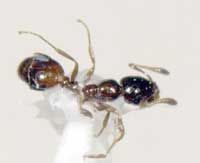Characteristics:
- Body 1/16 inch in length (monomorphic)
- Antennae have 12 segments with a 3-segmented club
- Shiny black
- Workers prey on insects and feed on honeydew produced by plant sucking insects such as aphids.
Little is known of the life history of this ant. Colonies are moderately sized to large, containing up to 2,000 workers and many queens. Colonies consist almost exclusively of workers and brood (eggs, larvae, and pupae) during most of the year, but winged males and females are produced during the summer. Nuptial flights have not been observed but probably occur. It is presumed that most nests are established by one or two queens. In the laboratory, queens may live approximately one year; workers may live about four months.
Distribution
A native species, the little black ant is widely distributed throughout southeastern Canada as well as northern and eastern sections of the United States, southward to the Pacific Coast. It is common in the southern half of California and in the San Francisco Bay area. The little black ant, Monomorium minimum (Buckley), has highly adaptive nesting habits. Nests can be found in the soil in open areas of lawns or under objects such as stones, bricks, wood and logs. In buildings, they nest in woodwork, wall voids, masonry, and under carpets. At high population densities, little black ants may become widely dispersed throughout a structure and invade nearly every crack and crevice. They are highly visible on established foraging trails, particularly when they invade food cabinets and pantries.
Management
Little black ant colonies in and around buildings generally are not numerous. They can usually be controlled by limited insecticide applications or the use of baits. Surveys should be done inside and outside to locate all nests. Outdoor colonies can be treated with a residual insecticide by drenching the nest sites, using a compressed sprayer. Nests in wall voids can be treated by injecting aerosol through cracks and crevices and around baseboards. If nests cannot be located, toxic baits can be effective when placed on foraging trails. It is a good idea to remove all liter and objects under which ants can nest and to seal all cracks in exterior walls where ants can enter